Saturday, November 26, 2005
Snowman
 This morning.
This morning.What is the best way to represent Canada from abroad?
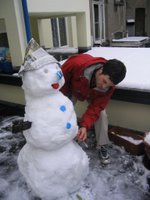
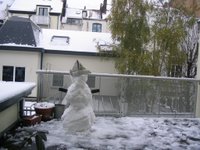 With beer bottle caps for eyes and chocolate boxes for a nose and arms - a touch of Belgium.
With beer bottle caps for eyes and chocolate boxes for a nose and arms - a touch of Belgium.Friday, November 25, 2005
Snow
 First snow of the year is here, forecasted to continue for 2 more days. The biggest fluffiest flakes I have ever seen. The streets are slushy and the cars are invisble under the blanket of snow. A street sander just went up our street. It feels like Canada.
First snow of the year is here, forecasted to continue for 2 more days. The biggest fluffiest flakes I have ever seen. The streets are slushy and the cars are invisble under the blanket of snow. A street sander just went up our street. It feels like Canada.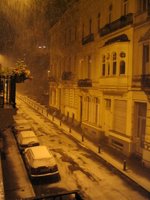
(without flash)
Thursday, November 24, 2005
A new power drill
Some of my new friends bought me a power drill for my birthday. This will be very handy, lack of closet space means we need to put up hooks, rails, and shelves.
The cold European winter has set in, with the coldest winter in 50 years predicted for Belgium. We have had hail already along with the 1C rain. I am finding it hard to find a decent male scarf. But with all this, we still get the occassional sunny warm day just to make it bareable. This time next week I will be back in Winnipeg, I will try to leave the rain behind.
The cold European winter has set in, with the coldest winter in 50 years predicted for Belgium. We have had hail already along with the 1C rain. I am finding it hard to find a decent male scarf. But with all this, we still get the occassional sunny warm day just to make it bareable. This time next week I will be back in Winnipeg, I will try to leave the rain behind.
Monday, November 14, 2005
All Quiet on the Western Front [3/3]
Sunday, Nov. 13, 2005 [3/3 - scroll down for parts 1 +2]
We drove further west along the front line from Amiens to Vimy Ridge (war photos here), probably the highlight of the weekend for me. Here we walked the trenches and up to 1km of the tunnels dug under the trenches.
 The tunnels were 10 to 25 meters down and of comfortable size for a single person to walk down. It was 11C in here year round. Above ground we could see that the German and British front lines were within 25 m of eachother, or just a grenades throw away. Most of the front lines were this close together because of the lack of advancements, and the taking over of rival trenches when any advancement was made. Seeing how close together they were for years and years .....
The tunnels were 10 to 25 meters down and of comfortable size for a single person to walk down. It was 11C in here year round. Above ground we could see that the German and British front lines were within 25 m of eachother, or just a grenades throw away. Most of the front lines were this close together because of the lack of advancements, and the taking over of rival trenches when any advancement was made. Seeing how close together they were for years and years .....

Not too cramped in here. A pile of war time trench warfare crap.
 Unexploded shell in wall. Fall asleep at the front and you could get a bomb in the head, ten 10 meters down.
Unexploded shell in wall. Fall asleep at the front and you could get a bomb in the head, ten 10 meters down.
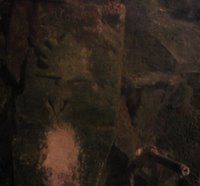 Graffiti on the walls, this one in the room the soldiers gathered before storming across the lines. This carving made long before the Canadian flag took its modern form.
Graffiti on the walls, this one in the room the soldiers gathered before storming across the lines. This carving made long before the Canadian flag took its modern form.

Walking the Vimy Ridge trenches
 The Mine crater called Winnipeg (there is also Montreal and Grange)
The Mine crater called Winnipeg (there is also Montreal and Grange)


Shelled field now grown over with trees and grass. Photo taken from German side towards the Canadian side.
Arras, home of the tapestry, for lunch and then drove back to Belgium to visit Ypres. We visited a number of cemeteries through out the weekend, this was one of the largest. Tyne Cot Memorial at Passchendaele though was another monument with 10s of 1000s of names from unfound bodies, it had many actual graves from bodies/parts that were found. This was situated just outside Ypres.
 Tyne Cot, overlooking Ypres
Tyne Cot, overlooking Ypres
Before getting to downtown Ypres we visited Sanctuary Wood and its Hill 62 museum. Another set of preserved trenches, yet much more life-like. Grass has not been allowed to take over the ground, sand bags have not been replaced by cement replicas and the ground of the trenches was exposed mud. The museum itself was just a collection of crap that the local farmers have collected from their fields over the years since reclaiming the land for agricultural use. In the 90's they were still collecting 10 tonnes of war time junk on a yearly basis around here. The museum doubled as a bar.
 Hill62 museum: preserved trenches
Hill62 museum: preserved trenches
The zigzag of the front line

Walking through the trenches. Section with a makeshift cover.

Entering a bunker from the trench.
 Hill62 museum: collected war waste
Hill62 museum: collected war waste
The town of Ypres was completely flattened during the war and has since been rebuilt, including the Cloth Hall, the city's town hall. Nothing in this town is older that 85 years old. Much f it was rebuilt to look as it did before the war. This particular building is considered one of the "best" non religious buildings in Europe.
 Cloth Hall
Cloth Hall
Finally at the entrance to the rebuilt old town of Ypres was the Menin Gate. Another monument with names of missing soldiers, this one including the names of members of the British army from India. In 1928, the local fire brigade began a tradition of performing the Last Post every night at 8pm under this monument (listen to the ceremony here - mp3). We saw the 26472nd performance. The gate is on Menin street leading to the town of Menin
 Menin Gate (I had trouble getting a decent photo)
Menin Gate (I had trouble getting a decent photo)
 The gathering crowd under the Menin Gate for the Last Post. A solemn and appropriate end to this trip through a portion of the history of WW1.
The gathering crowd under the Menin Gate for the Last Post. A solemn and appropriate end to this trip through a portion of the history of WW1.
We drove further west along the front line from Amiens to Vimy Ridge (war photos here), probably the highlight of the weekend for me. Here we walked the trenches and up to 1km of the tunnels dug under the trenches.
 The tunnels were 10 to 25 meters down and of comfortable size for a single person to walk down. It was 11C in here year round. Above ground we could see that the German and British front lines were within 25 m of eachother, or just a grenades throw away. Most of the front lines were this close together because of the lack of advancements, and the taking over of rival trenches when any advancement was made. Seeing how close together they were for years and years .....
The tunnels were 10 to 25 meters down and of comfortable size for a single person to walk down. It was 11C in here year round. Above ground we could see that the German and British front lines were within 25 m of eachother, or just a grenades throw away. Most of the front lines were this close together because of the lack of advancements, and the taking over of rival trenches when any advancement was made. Seeing how close together they were for years and years .....
Not too cramped in here. A pile of war time trench warfare crap.
 Unexploded shell in wall. Fall asleep at the front and you could get a bomb in the head, ten 10 meters down.
Unexploded shell in wall. Fall asleep at the front and you could get a bomb in the head, ten 10 meters down. Graffiti on the walls, this one in the room the soldiers gathered before storming across the lines. This carving made long before the Canadian flag took its modern form.
Graffiti on the walls, this one in the room the soldiers gathered before storming across the lines. This carving made long before the Canadian flag took its modern form.
Walking the Vimy Ridge trenches
 The Mine crater called Winnipeg (there is also Montreal and Grange)
The Mine crater called Winnipeg (there is also Montreal and Grange)

Shelled field now grown over with trees and grass. Photo taken from German side towards the Canadian side.
Arras, home of the tapestry, for lunch and then drove back to Belgium to visit Ypres. We visited a number of cemeteries through out the weekend, this was one of the largest. Tyne Cot Memorial at Passchendaele though was another monument with 10s of 1000s of names from unfound bodies, it had many actual graves from bodies/parts that were found. This was situated just outside Ypres.
 Tyne Cot, overlooking Ypres
Tyne Cot, overlooking YpresBefore getting to downtown Ypres we visited Sanctuary Wood and its Hill 62 museum. Another set of preserved trenches, yet much more life-like. Grass has not been allowed to take over the ground, sand bags have not been replaced by cement replicas and the ground of the trenches was exposed mud. The museum itself was just a collection of crap that the local farmers have collected from their fields over the years since reclaiming the land for agricultural use. In the 90's they were still collecting 10 tonnes of war time junk on a yearly basis around here. The museum doubled as a bar.
 Hill62 museum: preserved trenches
Hill62 museum: preserved trenchesThe zigzag of the front line

Walking through the trenches. Section with a makeshift cover.

Entering a bunker from the trench.
 Hill62 museum: collected war waste
Hill62 museum: collected war wasteThe town of Ypres was completely flattened during the war and has since been rebuilt, including the Cloth Hall, the city's town hall. Nothing in this town is older that 85 years old. Much f it was rebuilt to look as it did before the war. This particular building is considered one of the "best" non religious buildings in Europe.
 Cloth Hall
Cloth HallFinally at the entrance to the rebuilt old town of Ypres was the Menin Gate. Another monument with names of missing soldiers, this one including the names of members of the British army from India. In 1928, the local fire brigade began a tradition of performing the Last Post every night at 8pm under this monument (listen to the ceremony here - mp3). We saw the 26472nd performance. The gate is on Menin street leading to the town of Menin
 Menin Gate (I had trouble getting a decent photo)
Menin Gate (I had trouble getting a decent photo) The gathering crowd under the Menin Gate for the Last Post. A solemn and appropriate end to this trip through a portion of the history of WW1.
The gathering crowd under the Menin Gate for the Last Post. A solemn and appropriate end to this trip through a portion of the history of WW1.Guns of August [1+2/3]
Our Remembrance Day weekend took us along some of the Western front lines of WW1 in northern France. Starting at the Clery-sur-Sommes and ending in Ypres, stopping along the way at museums, cemeteries and memorials around Peronne, Amiens and Arras in Artois, France and Ypres in Flanders, Belgium. Chronologically we followed the front from the declaration of war at Clery-sur-Somme museum (l'Historial de la Grande Guerre de Peronne) to Armistice at the Menin Gate with the Last Post.
Friday Nov. 11, 2005 [1 of 3]
A 2 hour drive from Brussels to Peronne brought us to l'Historial de la Grande Guerre de Peronne, whose main exhibits were displaying the standard issue equipment and uniforms of the different countries represented in the war and the art of Otto Dix.
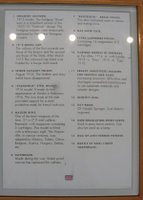
 British army items, and on the right, their descriptions.
British army items, and on the right, their descriptions.
 Scottish army with South African army in the background. Note the quilt.
Scottish army with South African army in the background. Note the quilt.
 Belongings of nurses and doctors at the front
Belongings of nurses and doctors at the front
 The old castle which the museum is in, we ate lunch in the dungeon of this.
The old castle which the museum is in, we ate lunch in the dungeon of this.

We walked the rampart that still exists in the city. This is the moat.

Next stop: Lochnagar Crater. The result of the July 1, 1916 British mine explosion (on purpose) containing 66,000lbs of ammonal in two charges 18 meters below the surface. The explosions was then the loudest man-made sound in history, and could be heard in London. The mine created a crater 80 meters across and 30 meters deep, with a 3 meter high lip. The Tyneside Irish and Tyneside Scottish battalions lost 6,380 officers and men that day, and was the hardest-hit British division.

Just off in the distance we could see Thiepval. A memorial to the 58 000 that died on July 1st, 1916 and 72 087 soldiers never found. Graves of the French marked with crosses and English with the headstones.


Thiepval.

The crosses on the left are French graves, and the headstones on the right are British graves.
 Each one of these legs to the monument had names, for a total of about 72 000.
Each one of these legs to the monument had names, for a total of about 72 000.
The next monument was Beaumont Hamel, the Canadian Park dedicated to the role of the Newfoundland soldiers. The park has preserved the trench system they built for their main battle. Though the trees are new, as is the wooden duck walk in the trenches,, it gave a sense of how small the space was and how close they were to the enemy. The operators and tour guides of the park are Canadians as it is Canadian land donated by the French originally to the colony of Newfoundland.

Fortunately for us the area had grown over with grass and trees, and the Government of Canada had laid down a walkway in the trenches so we could keep our shoes clean. This was very different back in the war but it gave us a better feel for what it would have been like.

The moose monument at Beaumont Hamel in the background, the symbol of Newfoundland.
We then arrived in Amiens for dinner, a night on the town and our hotel. We remained in Amiens for the following day......
Saturday Nov. 12, 2005 [part 2 of 3]
Amiens was a city almost completely destroyed by WW1, except for the Cathedral Notre Dame which was saved by orders from high in German command. Built in the 13th century, it is twice as big as the Paris cathedral of the same name and is listed in the UNESCO Heritage. It also contain the head of St. John the Baptist, stolen from the body of the statue in Constantinople during the 4th crusade by Wallon de Starton. Science has not been able to deny this claim as it is a skull of the right age person from the right era. At night the cathedral is lit up to appear as it did when it was first built because they used to paint all the statues.
 We had the best tour guide for a very indepth tour of this church
We had the best tour guide for a very indepth tour of this church

Worshipping St. John the Baptists head.
 We visited the St. Acheul archaeological site, which had this viewing tower to see the whole area and drove by Jules Vernes house. Something stuck to the lense in this photo that was wearing a red jacket.
We visited the St. Acheul archaeological site, which had this viewing tower to see the whole area and drove by Jules Vernes house. Something stuck to the lense in this photo that was wearing a red jacket.
The final planned part of the day was the Picardie museum. A large museum including works of El Greco, Rodin, Picasso, etc. and a whole floor dedicated to the archaeological history of the area.
Then it was off to the Amiens on the Somme for dinner.
Friday Nov. 11, 2005 [1 of 3]
A 2 hour drive from Brussels to Peronne brought us to l'Historial de la Grande Guerre de Peronne, whose main exhibits were displaying the standard issue equipment and uniforms of the different countries represented in the war and the art of Otto Dix.

 British army items, and on the right, their descriptions.
British army items, and on the right, their descriptions. Scottish army with South African army in the background. Note the quilt.
Scottish army with South African army in the background. Note the quilt. Belongings of nurses and doctors at the front
Belongings of nurses and doctors at the front The old castle which the museum is in, we ate lunch in the dungeon of this.
The old castle which the museum is in, we ate lunch in the dungeon of this.
We walked the rampart that still exists in the city. This is the moat.

Next stop: Lochnagar Crater. The result of the July 1, 1916 British mine explosion (on purpose) containing 66,000lbs of ammonal in two charges 18 meters below the surface. The explosions was then the loudest man-made sound in history, and could be heard in London. The mine created a crater 80 meters across and 30 meters deep, with a 3 meter high lip. The Tyneside Irish and Tyneside Scottish battalions lost 6,380 officers and men that day, and was the hardest-hit British division.

Just off in the distance we could see Thiepval. A memorial to the 58 000 that died on July 1st, 1916 and 72 087 soldiers never found. Graves of the French marked with crosses and English with the headstones.


Thiepval.

The crosses on the left are French graves, and the headstones on the right are British graves.
 Each one of these legs to the monument had names, for a total of about 72 000.
Each one of these legs to the monument had names, for a total of about 72 000.The next monument was Beaumont Hamel, the Canadian Park dedicated to the role of the Newfoundland soldiers. The park has preserved the trench system they built for their main battle. Though the trees are new, as is the wooden duck walk in the trenches,, it gave a sense of how small the space was and how close they were to the enemy. The operators and tour guides of the park are Canadians as it is Canadian land donated by the French originally to the colony of Newfoundland.

Fortunately for us the area had grown over with grass and trees, and the Government of Canada had laid down a walkway in the trenches so we could keep our shoes clean. This was very different back in the war but it gave us a better feel for what it would have been like.

The moose monument at Beaumont Hamel in the background, the symbol of Newfoundland.
We then arrived in Amiens for dinner, a night on the town and our hotel. We remained in Amiens for the following day......
Saturday Nov. 12, 2005 [part 2 of 3]
Amiens was a city almost completely destroyed by WW1, except for the Cathedral Notre Dame which was saved by orders from high in German command. Built in the 13th century, it is twice as big as the Paris cathedral of the same name and is listed in the UNESCO Heritage. It also contain the head of St. John the Baptist, stolen from the body of the statue in Constantinople during the 4th crusade by Wallon de Starton. Science has not been able to deny this claim as it is a skull of the right age person from the right era. At night the cathedral is lit up to appear as it did when it was first built because they used to paint all the statues.
 We had the best tour guide for a very indepth tour of this church
We had the best tour guide for a very indepth tour of this church
Worshipping St. John the Baptists head.
 We visited the St. Acheul archaeological site, which had this viewing tower to see the whole area and drove by Jules Vernes house. Something stuck to the lense in this photo that was wearing a red jacket.
We visited the St. Acheul archaeological site, which had this viewing tower to see the whole area and drove by Jules Vernes house. Something stuck to the lense in this photo that was wearing a red jacket.The final planned part of the day was the Picardie museum. A large museum including works of El Greco, Rodin, Picasso, etc. and a whole floor dedicated to the archaeological history of the area.
Then it was off to the Amiens on the Somme for dinner.
Thursday, November 10, 2005
Remembrance Day
This weekend, starting Friday morning, will be a big history lesson by two history proffs, mostly on WW1.
(Pieces from the itinerary)
Friday
WW1 Videos on the bus to our start in Péronne (to see war museums and art icluding drawings by German painter and engraver, Otto Dix (1891-1969)). Follow the frontline, Cléry-sur-Somme to Lochnagar crater. Thiepval (Memorial honors 72, 087 soldiers whose bodies were never found) to Beaumont Hamel Memorial Park and trench lines (dedicated to the memory of New Foundland’s troops). Pass by Albert on the way to Amiens.
Saturday
Cathedral, shopping, home of Jules Verne, the Saint Acheul gardens (archeology site of a human settlement dating from the early Stone Age (ca 280, 000 years ago). Museum of Picardie (incl. exhibition on Puvis de Chavannes (1824-1898), Roman and early Christian artifacts, medieval sculptures and paintings as well as 19th and 20th c. art works).
Sunday
Amiens to the tunnels dug by the Canadians at Vimy Ridge. Drive to Arras, then back to Belgium, see Tyne Cot, cemetery for the battles of Ypres, to the Sanctuary Wood trench (kept in the state it was at the end of the war when Canadians left them). Drive into Ypres. To Cloth Hall (rebuilt), to Menin, attend the ceremony "the Last Post". Then back to Brussels.
(Pieces from the itinerary)
Friday
WW1 Videos on the bus to our start in Péronne (to see war museums and art icluding drawings by German painter and engraver, Otto Dix (1891-1969)). Follow the frontline, Cléry-sur-Somme to Lochnagar crater. Thiepval (Memorial honors 72, 087 soldiers whose bodies were never found) to Beaumont Hamel Memorial Park and trench lines (dedicated to the memory of New Foundland’s troops). Pass by Albert on the way to Amiens.
Saturday
Cathedral, shopping, home of Jules Verne, the Saint Acheul gardens (archeology site of a human settlement dating from the early Stone Age (ca 280, 000 years ago). Museum of Picardie (incl. exhibition on Puvis de Chavannes (1824-1898), Roman and early Christian artifacts, medieval sculptures and paintings as well as 19th and 20th c. art works).
Sunday
Amiens to the tunnels dug by the Canadians at Vimy Ridge. Drive to Arras, then back to Belgium, see Tyne Cot, cemetery for the battles of Ypres, to the Sanctuary Wood trench (kept in the state it was at the end of the war when Canadians left them). Drive into Ypres. To Cloth Hall (rebuilt), to Menin, attend the ceremony "the Last Post". Then back to Brussels.
Monday, November 07, 2005
2 days in St Gallen, Che
A ten hour trip from Brussels through Luxembourg and France is St. Gallen Sw., about 45 minutes from Zurich. Home of the textile museum . The main reason this town is a UNESCO World Heritage Site is the Abbey of St. Gall [ AND ] and the Stiftsbibliothek St Gallen that has books up to 1200 years old and a 700 BC mummy that has been in the library for 200 years. There is also the Universität St.Gallen built into the top of one of the hills in town, much like a Hobbit village. The rest of the town is obviously the model used to design Canadian ski resorts. This place is out of a postcard.... In town on the hills slopes are cows and sheep grazing, people hike, and kids run around playing a game where they call out 'Ricolla' (its more of a taunt than a call). A recent banking complex was constructed and they enlisted the help of a famous Swiss artist (I don't know who) and painted the streets of the area red, like a carpet but with a stucco/rubber material. Furniture was made in the same material and it was open to cars etc. like a normal street. We arrived just as it had completed and still smelled of paint. It looked very neat at night.
While at the Universitat St. Gallen, where students leave their laptops unattended for long periods of time, bananas are handed out for free. Downtown you get apples. Food was very expensive, but products were cheap, I may have to go back when I get a job to buy a bike.
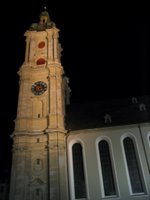 The steeple at the St. Gallen monestary (Abbey of St. Gall UNESCO World Heritage Site).
The steeple at the St. Gallen monestary (Abbey of St. Gall UNESCO World Heritage Site).
 Over looking the town and Lake Constance from Dreilinden hike. That is three lakes up the hill south of the town. See the cows? BTW, Lake Constance is on the border of Switzerland, Germany and Austria.
Over looking the town and Lake Constance from Dreilinden hike. That is three lakes up the hill south of the town. See the cows? BTW, Lake Constance is on the border of Switzerland, Germany and Austria.
 Further down the hill, with a full view of Abbey St. Gall. The steeple on the right is St. Laurenzen-Kirche mit Aussichtsturm (Church of St. Lawrence)
Further down the hill, with a full view of Abbey St. Gall. The steeple on the right is St. Laurenzen-Kirche mit Aussichtsturm (Church of St. Lawrence)
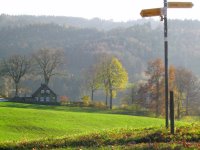 Up the hill further past the Dreilinden and over the other side..... true Switzerland: cows, bells, chalets....
Up the hill further past the Dreilinden and over the other side..... true Switzerland: cows, bells, chalets....
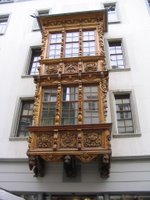 Very nice wood work on buildings around town.
Very nice wood work on buildings around town.
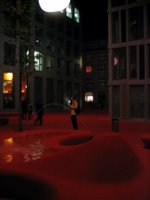 A new bank was just completed and the whole area around it was had the roads and sidewalks painted red. The surface looked just like a red carpet. Very neat.
A new bank was just completed and the whole area around it was had the roads and sidewalks painted red. The surface looked just like a red carpet. Very neat.
While at the Universitat St. Gallen, where students leave their laptops unattended for long periods of time, bananas are handed out for free. Downtown you get apples. Food was very expensive, but products were cheap, I may have to go back when I get a job to buy a bike.
 The steeple at the St. Gallen monestary (Abbey of St. Gall UNESCO World Heritage Site).
The steeple at the St. Gallen monestary (Abbey of St. Gall UNESCO World Heritage Site). Over looking the town and Lake Constance from Dreilinden hike. That is three lakes up the hill south of the town. See the cows? BTW, Lake Constance is on the border of Switzerland, Germany and Austria.
Over looking the town and Lake Constance from Dreilinden hike. That is three lakes up the hill south of the town. See the cows? BTW, Lake Constance is on the border of Switzerland, Germany and Austria. Further down the hill, with a full view of Abbey St. Gall. The steeple on the right is St. Laurenzen-Kirche mit Aussichtsturm (Church of St. Lawrence)
Further down the hill, with a full view of Abbey St. Gall. The steeple on the right is St. Laurenzen-Kirche mit Aussichtsturm (Church of St. Lawrence) Up the hill further past the Dreilinden and over the other side..... true Switzerland: cows, bells, chalets....
Up the hill further past the Dreilinden and over the other side..... true Switzerland: cows, bells, chalets.... Very nice wood work on buildings around town.
Very nice wood work on buildings around town. A new bank was just completed and the whole area around it was had the roads and sidewalks painted red. The surface looked just like a red carpet. Very neat.
A new bank was just completed and the whole area around it was had the roads and sidewalks painted red. The surface looked just like a red carpet. Very neat.Sunday, November 06, 2005
Brussels to St. Gallen, Sw
Our trip from Brussels to St. Gallen, Che took 10 hours by train with a short stopover in Olten, Che. We passed through Luxembourg (the City and Country). Here are some of our pictures from the train and our time in Olten.
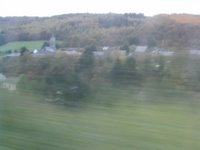 Getting the hang of shooting out the window of a speeding train.
Getting the hang of shooting out the window of a speeding train.
 The neucular power plant by Goesgen, Che.
The neucular power plant by Goesgen, Che.
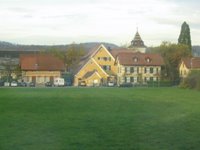 Typical Swiss village seen from the train.
Typical Swiss village seen from the train.
 A covered bridge in Olten. A river alongside the train station, didn't get to venture far from here.
A covered bridge in Olten. A river alongside the train station, didn't get to venture far from here.
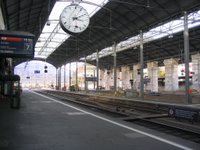 Olten train station. A quiet stop in a quiet town.
Olten train station. A quiet stop in a quiet town.
 Getting the hang of shooting out the window of a speeding train.
Getting the hang of shooting out the window of a speeding train. The neucular power plant by Goesgen, Che.
The neucular power plant by Goesgen, Che. Typical Swiss village seen from the train.
Typical Swiss village seen from the train. A covered bridge in Olten. A river alongside the train station, didn't get to venture far from here.
A covered bridge in Olten. A river alongside the train station, didn't get to venture far from here. Olten train station. A quiet stop in a quiet town.
Olten train station. A quiet stop in a quiet town.Friday, November 04, 2005
St. Gallen, Switzerland
Hi, I am currently on a short trip to St. Gallen. Plan to be home Saturday night. Have taken a lot of pictures.
Receive an email each time this page is updated
Hangman









